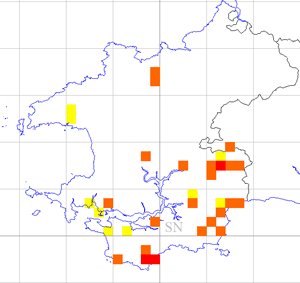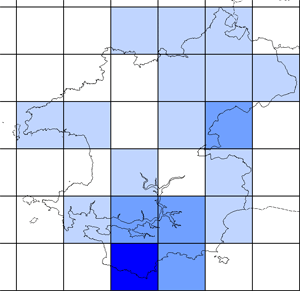During the 20 year period between 1984-88 and 2003-07 there has been a quite dramatic decline in Green Woodpecker distribution across Pembrokeshire, indicated by a 77% decrease in the number of tetrads in which they were found. This decline is contrary to the BBS population index, which appears to indicate an overall 48% increase across Wales as a whole between 1994 and 2007. Within Pembrokeshire, the population appears to have shrunk towards the south and south-east. Apart from some outliers on the St David’s peninsula and in the Gwaun Valley, they now appear to have all but disappeared in the north.
Examination of the 1988-91 National Atlas is also revealing. Pembrokeshire and other counties in Wales (and also notably in Cornwall), recorded many more 10 km-squares with losses of confirmed breeding Green Woodpeckers, than gains between the first national breeding birds atlas (1968–72) and the second atlas, 20 years later. This seems to much more closely represent the trends found in the local atlas, compared with the BBS population index. Even from the 1984-88 atlas survey, Donovan and Rees regarded the Green Woodpecker distribution as patchy across the county. They estimated that the average density may have been as high as one to two pairs per occupied tetrad and suggested a population then of about 140 – 280 pairs. Translating this to 2003-07 would therefore suggest a population of about 32 – 64 pairs. Even this seems to be a high number, considering how difficult they were to find during the five years of atlas fieldwork.
Up to 2007 at least, Stackpole National Nature Reserve, on the Castlemartin peninsula remained as one of their most reliable breeding areas, where one or two pairs regularly nested during the atlas survey period. Here there are still reasonably healthy ant populations in unimproved invertebrate-rich dune and maritime grassland, supporting yellow ant hills at a density of up to 550 per hectare. Green Woodpeckers feed over Stackpole Warren but have also been found searching for food in the limestone-crevices on the sea cliffs.
Just why Green Woodpeckers appear to be in steep decline in Pembrokeshire is unknown. Recent on-line species maps, from the early period of the 2007 – 11 joint national winter and breeding atlas is also revealing. Provisional distribution maps suggest that there has been a contraction in their population in Wales. This is particularly evident in neighbouring Ceredigion to the north, where breeding evidence is fairly patchy and they also appear to be largely absent from west Carmarthenshire.
Is climate an issue? Could changes in grassland management have led to a loss of invertebrate prey, especially ants? Could this be subtly linked to local declines in the Rabbit population since the arrival of viral haemorrhagic disease in the early 1990’s, on top of already established seasonal outbreaks of myxomatosis? Have there been subtle changes in woodland management that may be a contributing factor? Whatever the reason or combinations of factors involved, further local research is needed to identify the main causes and to see if positive management can be introduced to halt the decline.
Bob Haycock

Fieldwork 2003-07 (based on 490 tetrads)
Red = breeding confirmed = 3
Orange = breeding probable = 20
Yellow = breeding possible = 9
Total tetrads in which registered = 32 (6.5%)
 Tuesday, March 6, 2018 at 6:41PM
Tuesday, March 6, 2018 at 6:41PM  Pembrokeshire Avifauna committee | Comments Off |
Pembrokeshire Avifauna committee | Comments Off |  scarce in
scarce in  Green Woodpecker
Green Woodpecker 





